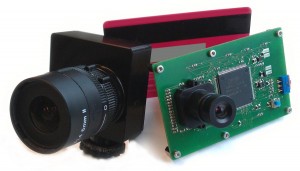Category: Cognitive Navigation
Brain Mechanisms of Navigation in Physical and Cognitive Spaces
The following lectures are presented in the NEUROSCIENCE SYMPOSIUM : BRAIN MECHANISMS OF NAVIGATION IN PHYSICAL AND COGNITIVE SPACES at Central European University in August 31, 2017.
This is a special symposium with four outstanding scientist (three Nobel laureates and one Brain Prize winner) …
Dynamic Vision Sensor (DVS)
From inilabs.com
DVS Overview
 Conventional vision sensors see the world as a series of frames. Successive frames contain enormous amounts of redundant information, wasting memory access, RAM, disk space, energy, computational power and time. In addition, each frame imposes the …
Conventional vision sensors see the world as a series of frames. Successive frames contain enormous amounts of redundant information, wasting memory access, RAM, disk space, energy, computational power and time. In addition, each frame imposes the …
HD Maps: New age maps powering autonomous vehicles
From GeospatialWorld by Harsha Vardhan September 22, 2017
High Definition Maps or HD Maps are the new generation maps that are powering machines and self-driving cars & autonomous cars. Read this article to understand everything about HD Maps. Full credit for …
ETH ANYmal: a quadrupedal robot designed for autonomous operation in challenging environments
 ANYmal is a quadrupedal robot designed for autonomous operation in challenging environments. Driven by special compliant and precisely torque controllable actuators, the system is capable of dynamic running and high-mobile climbing. Thanks to incorporated laser sensors and cameras, the robot …
ANYmal is a quadrupedal robot designed for autonomous operation in challenging environments. Driven by special compliant and precisely torque controllable actuators, the system is capable of dynamic running and high-mobile climbing. Thanks to incorporated laser sensors and cameras, the robot …
The Brain as a Multi-layered Map Scales and Reference Points for Pattern Recognition in Neuroimaging
Margarita Zaleshina, Alexander Zaleshin
Moscow Institute of Physics and Technology, Moscow, Russia
(Zaleshina, terbiosorg)@gmail.com
The paper provides an overview of brain mapping in neuroscience and describe the application of spatial data processing techniques to represent the brain as …
Bat brains: Studies of free-flying bats reveal nerve cells that enable complex navigation.
Bat brain signals illuminate navigation in the dark

Read more in the Science News https://www.sciencenews.org/article/bat-brain-signals-illuminate-navigation-dark …
为什么类脑(Rat-Brained)机器人能够在不熟悉的地形中进行很好地导航
为什么类脑(Rat-Brained)机器人能够在不熟悉的地形中进行很好地导航
Why Rat-Brained Robots Are So Good at Navigating Unfamiliar Terrain
运行模拟大鼠导航神经元的算法,能够使重型机器在澳大利亚的地下矿山中进行作业。
Jean Kumagai 1 June, 2017 翻译:Fangwen Yu 原文链接:IEEE Spectrum
Photo: Dan Saelinger
如果你把一只普通的棕色老鼠放在一个实验室的迷宫或地铁隧道里,它将立即开始探索周围的环境,嗅闻边缘,对着角落和障碍物,将其胡须刷在表面上。 过了一会儿,它会回到起步的地方,从此,它将把探索过的地形视为熟悉的环境。
机器人科学家长期以来一直梦想着给机器人创造类似的导航技能。 为了让机器人能够在我们的环境中变得更有用,机器人就必须具备在周围环境中靠自己寻路的能力。 有些机器人已经在家庭、办公室、仓库、医院、酒店以及自驾车,甚至整个城市范围内的环境中正在学习找路。尽管如此,这些机器人平台仍然难以在轻微挑战的条件下可靠地运行。 例如,自主驾驶车辆可能配备了复杂的传感器和前方道路的精细地图,但是司机仍然需要在大雨或下雪或夜间进行控制。
相比之下,棕色的老鼠是一个灵活的导航仪,在最恶劣的环境中也能找到路,比如在地下、地面等复杂情况下都没问题。 当一只老鼠探索一个不熟悉的区域时,在2克大脑中专门的神经元会放电或产生尖峰,对地标或边界产生响应。其他神经元以规则的距离形成尖峰, 每20厘米一次,每米一次等等,这样就形成一种空间的心理表征。还有其他的神经元就像一个内部的罗盘,记录着动物头部转动的方向。总而言之,这种神经活动允许大鼠记住它去过哪儿以及怎样到达那。 无论何时当沿着相同的道路行走,尖峰会加强,使大鼠的导航更加健壮。…
About
Brain Inspired Navigation Blog
New discovery worth spreading on brain-inspired navigation in neurorobotics and neuroscience
Recent Posts
- How zebrafish place cells integrate multiple sources of information and flexibly remap to form distinct spatial maps?
- How hippocampal neuronal activity is aligned with action plans?
- How ants use latent learning without map-like representation of space to navigate?
- How shifts in the composition of memory-encoding neuronal ensembles influence the evolution of a memory over time?
- Whether the entorhinal grid system is also involved in predicting where an animal will be in the next moment?
Tags
Categories
- 3D Movement
- 3D Navigation
- 3D Path Integration
- 3D Perception
- 3D SLAM
- 3D Spatial Representation
- AI Navigation
- Bio-Inspired Robotics
- Brain-Inspired Navigation
- Cognitive Map
- Cognitive Navigation
- Episodic Memory
- Excerpt Notes
- Flying Vehicle Navigation
- Goal Representation
- Insect Navigation
- Learning to Navigate
- Neural Basis of Navigation
- Path Integration
- Path Planning
- Project
- Research Tips
- Robotic Vision
- Self-Flying Vehicles
- Spatial Cognition
- Spatial Cognitive Computing
- Spatial Coordinate System
- Spatial Memory
- Time
- Unclassified
- Visual Cortex
- Visual Cue Cells
Links
- Laboratory of Nachum Ulanovsky
- Jeffery Lab
- BatLab
- The NeuroBat Lab
- Taube Lab
- Laurens Group
- Romani Lab
- Moser Group
- O’Keefe Group
- DoellerLab
- MilfordRobotics Group
- The Space and Memory group
- Angelaki Lab
- Spatial Cognition Lab
- McNaughton Lab
- Conradt Group
- The Fiete Lab
- The Cacucci Lab
- The Burak Lab
- Knierim Lab
- Clark Spatial Navigation & Memory Lab
- Computational Memory Lab
- The Dombeck Lab
- Zugaro Lab
- Insect Robotics Group
- The Nagel Lab
- Basu Lab
- Spatial Perception and Memory lab
- The Neuroecology lab
- The Nagel Lab
- Neural Modeling and Interface Lab
- Memory and Navigation Circuits Group
- Neural Circuits and Memory Lab
- The lab of Arseny Finkelstein
- The Epstein Lab
- Gu Lab (Spatial Navigation and Memory)
- Fisher Lab (Neural Circuits for Navigation)
- The Alexander Lab (Spatial Cognition and Memory)
- Harvey Lab (Neural Circuits for Navigation)
- Buzsáki Lab
- ……
